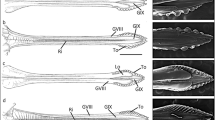Abstract
THE ecology of the terrestrial Enchytraeidae has been neglected mainly because of the lack of an adequate technique for assessing population size and partly because of taxonomic difficulties. Recently, Overgaard Nielsen1 has described a method for the large-scale extraction of these worms from soil. This consists of heating soil cores in an earthenware cylinder over a water-bath, and driving the worms upwards into a layer of cooled sand on top of the soil. The enchytraeids are then recovered by washing from the sand.
This is a preview of subscription content, access via your institution
Access options
Subscribe to this journal
Receive 51 print issues and online access
$199.00 per year
only $3.90 per issue
Buy this article
- Purchase on Springer Link
- Instant access to full article PDF
Prices may be subject to local taxes which are calculated during checkout
Similar content being viewed by others
References
Nielsen, C. Overgaard, Oikos, 4, 11 (1952–53).
Author information
Authors and Affiliations
Rights and permissions
About this article
Cite this article
O'CONNOR, F. Extraction of Enchytraeid Worms from a Coniferous Forest Soil. Nature 175, 815–816 (1955). https://doi.org/10.1038/175815b0
Issue Date:
DOI: https://doi.org/10.1038/175815b0
This article is cited by
-
Analysis of heat and cold tolerance of a freeze-tolerant soil invertebrate distributed from temperate to Arctic regions: evidence of selection for extreme cold tolerance
Journal of Comparative Physiology B (2022)
-
The contributions of enchytraeids and earthworms to the soil mineralization process in soils with fungicide
Ecotoxicology (2021)
-
Effects of a glyphosate-based herbicide on soil animal trophic groups and associated ecosystem functioning in a northern agricultural field
Scientific Reports (2019)
-
Short-term effects of two fungicides on enchytraeid and earthworm communities under field conditions
Ecotoxicology (2018)
-
Long-term and realistic global change manipulations had low impact on diversity of soil biota in temperate heathland
Scientific Reports (2017)
Comments
By submitting a comment you agree to abide by our Terms and Community Guidelines. If you find something abusive or that does not comply with our terms or guidelines please flag it as inappropriate.



